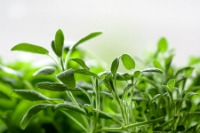Clear Your Mind with Sage

Sage, with its woody stems, grayish leaves, and lovely purplish-blue flowers, is a native perennial of the Northern Mediterranean coast and an herbal member of the mint family. If you’re only familiar with Sage for seasoning savory dishes, you’re missing out on a fascinating botanical remedy.
Ancient Greeks and Romans burned sage in ceremonies, believing it would impart wisdom. Early European herbalists used Sage to clear congestion, purify the blood, and cleanse the teeth. In Native American and indigenous cultures around the world, shamans use White Sage to cleanse both persons and spaces of evil influences. Priests still burn Sage in religious ceremonies. Even though we can’t prove Sage will raise your consciousness, many people burn Sage to facilitate relaxation during yoga or meditation.
Today, we know that Sage leaves and flowers contain chemicals with antibacterial, astringent, and antiseptic properties. At your local holistic market, you can find Sage in a variety of products. It is used in natural deodorant, and in mouthwash because it fights bacteria responsible for gum disease.
In herbal remedies, a sage tea or tincture can help ease sore throat, congestion, digestive cramping, and support mental wellness. In aromatherapy preparations, sage is most often used as an essential oil in an air diffuser or in candles. Dried White Sage is most commonly burned (known as smudging) as incense with the intention to clear the lungs, ease mental stress, and enhance mood.
Using Sage as a botanical remedy is very different from cooking with the herb. Medicinal preparations and essential oils derived from Sage contain thujones, a naturally occurring chemical in the plant. If you take a higher dose of medicinal Sage than is recommended, it could cause serious health problems such as tremors, rapid heart rate, vertigo and vomiting. Consult your holistic health practitioner for guidance on the safe use of any Sage remedy. And I’m here if you have questions on the use of essential sage oil.
References:
Mars, Bridgitte & Fiedler, Chrystle. Home Reference Guide to Holistic Health & Healing. (Beverly, MA: Fair Winds Press. 2015.), 30, 143, 203.
Johnson, Rebecca L. & Foster, Steven et al., National Geographic Guide to Medicinal Herbs: The World’s Most Effective Healing Plants.(National Geographic Society. 2010, 2014.), 90-93
Sage: Herb Wisdom.com http://www.herbwisdom.com/herb-sage.html
National Centers for Complementary and Integrative Health Info Sheet: Sage:https://nccih.nih.gov/health/sage
Smudging with Sage: http://www.mindbodygreen.com/0-17875/a-sage-smudging-ritual-to-cleanse-your-aura-clear-your-space.html
Walch SG, Kuballa T, Stühlinger W, Lachenmeier DW. “Determination of the biologically active flavour substances thujone and camphor in foods and medicines containing sage (Salvia officinalis L.)”.Chem Cent J. (Jul 21, 2011): 5-44. http://www.ncbi.nlm.nih.gov/pmc/articles/PMC3155476/
Kennedy, D. O., Wightman, E. L. “Herbal Extracts and Phytochemicals: Plant Secondary Metabolites and the Enhancement of Human Brain Function.” Advances in Nutrition: An International Review Journal. (11 January 2011): 2(1), 32-50. https://www.ncbi.nlm.nih.gov/pmc/articles/PMC3042794
MedLine Research Citations Indexed for Salvia officinalis in herbal teas and tinctures http://www.ncbi.nlm.nih.gov/pubmed
Photo Credit: Nordia/bigstockphoto.com
